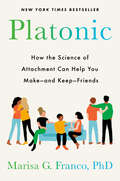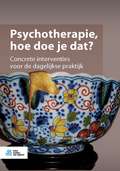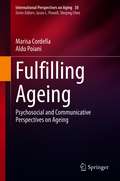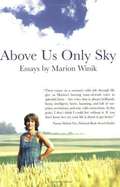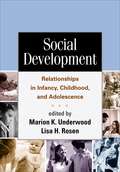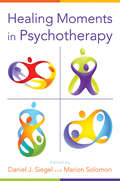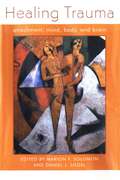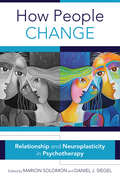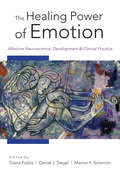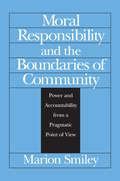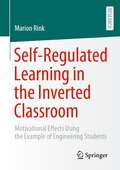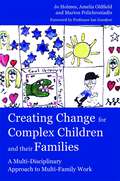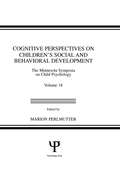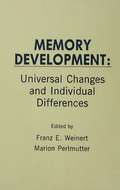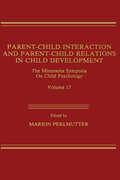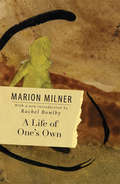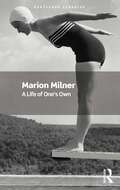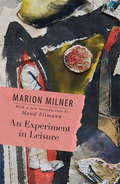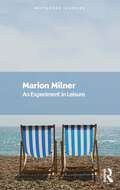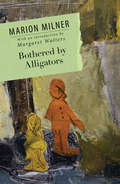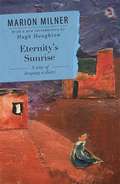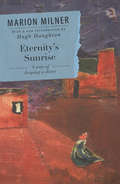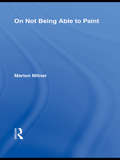- Table View
- List View
Platonic: How the Science of Attachment Can Help You Make--and Keep--Friends
by Marisa G. FrancoIs understanding the science of attachment the key to building lasting friendships and finding &“your people&” in an ever-more-fragmented world?How do we make and keep friends in an era of distraction, burnout, and chaos, especially in a society that often prizes romantic love at the expense of other relationships? In Platonic, Dr. Marisa G. Franco unpacks the latest, often counterintuitive findings about the bonds between us—for example, why your friends aren&’t texting you back (it&’s not because they hate you!), and the myth of &“friendships happening organically&” (making friends, like cultivating any relationship, requires effort!). As Dr. Franco explains, to make and keep friends you must understand your attachment style—secure, anxious, or avoidant: it is the key to unlocking what&’s working (and what&’s failing) in your friendships.Making new friends, and deepening longstanding relationships, is possible at any age—in fact, it&’s essential. The good news: there are specific, research-based ways to improve the number and quality of your connections using the insights of attachment theory and the latest scientific research on friendship. Platonic provides a clear and actionable blueprint for forging strong, lasting connections with others—and for becoming our happiest, most fulfilled selves in the process.
Psychotherapie, hoe doe je dat?: Concrete interventies voor de dagelijkse praktijk
by Marisa Donner-QuanjerDit boek helpt psychologen en psychotherapeuten handiger om te gaan met de vele, vaak onverwachte complexe situaties waar zij in de praktijk mee worden geconfronteerd. En het helpt ze echt naar cliënten te luisteren en hen op de juiste gedetailleerde manier te bevragen. Het boek is primair geschreven voor psychotherapeuten, GZ psychologen en klinisch psychologen in opleiding, maar is ook geschikt voor basispsychologen en andere zorgprofessionals.Psychotherapie, hoe doe je dat? Concrete interventies voor de dagelijkse praktijk is een gebruiksboek. Het hoeft niet van kaft tot kaft gelezen te worden, de lezer kan in de inhoudsopgave opzoeken wat hij meent nodig te hebben. Het boek bevat suggesties en aanbevelingen voor concrete interventies in lastige situaties en bij complexe cliënten in de psychotherapeutische praktijk van alledag. De tien hoofdstukken behandelen onder meer de intake, het maken van een behandelplan, specifieke gesprekstechnieken en verschillende vignetten over thema’s en klachten.
Fulfilling Ageing: Psychosocial and Communicative Perspectives on Ageing (International Perspectives on Aging #30)
by Aldo Poiani Marisa CordellaThis book explores the reality of ageing and old age from the perspectives of the individual and society. It emphasizes cross-cultural aspects of ageing and communication issues both within and across generations. The authors approach the understanding of ageing from a multi-disciplinary perspective, integrating biology, psychology, linguistics, sociology, and history. The book is organized as follows: historical and broader cross-cultural issues of ageing, followed by biomedical, psychological, social, and communicative aspects of ageing. The book concludes with an in-depth analysis of the existential dimension of ageing followed by an evolutionary perspective.
Above Us Only Sky
by Marion WinikFrom the book: There are writers who make you laugh yourself silly, writers who make you weep, writers who make you think more deeply about your life and your world. As NPR listeners and Marion Winik fans know, this sparkling, high-energy essayist does all three. Whether she is regaling us with stories about parenting her brood of children and stepchildren ages four to seventeen, recounting poignant stories of her childhood-or juicier ones from her adulthood-Winik's newest offering is a treat for dedicated fans and new readers alike.
Social Development
by Marion Underwood Lisa RosenThis authoritative, engaging text examines the key role of relationships in child and adolescent development, from the earliest infant-caregiver transactions to peer interactions, friendships, and romantic partnerships. Following the sequence of a typical social development course, sections cover foundational developmental science, the self and relationships, social behaviors, contexts for social development, and risk and resilience. Leading experts thoroughly review their respective areas and highlight the most compelling current issues, methods, and research directions. End-of-chapter suggested reading lists direct students and instructors to exemplary primary sources on each topic
Healing Moments in Psychotherapy (Norton Series on Interpersonal Neurobiology)
by Daniel J. Siegel Marion SolomonDistinguished clinicians explain what lies at the heart of change in effective psychotherapy. A wide range of distinguished scientists and clinicians discuss the nature of change in the therapeutic process. Jaak Panksepp, Ian McGilchrist, Ruth Lanius, Francine Shapiro, and other luminaries offer readers a powerful journey through mindful awareness, neural integration, affective neuroscience, and therapeutic presence to reveal the transformational nature of therapy. Healing Moments in Psychotherapy dives deep into the art and science of healing from the perspective of a variety of clinical approaches and scientific viewpoints, including interpersonal neurobiology. Through the voices of a dozen clinicians and scientists presenting their combined experiences and wisdom, it serves as a window into the process of healing. Practical examples and empowering research data support the ways in which therapeutic relationships can help catalyze health and restore wellness within psychotherapy.
Healing Trauma: Attachment, Mind, Body and Brain
by Daniel J. Siegel Marion Solomon<P> Born out of the excitement of a convergence of ideas and passions, this book provides a synthesis of the work of researchers, clinicians, and theoreticians who are leaders in the field of trauma, attachment, and psychotherapy. <P> As we move into the third millennium, the field of mental health is in an exciting position to bring together diverse ideas from a range of disciplines that illuminate our understanding of human experience: neurobiology, developmental psychology, traumatology, and systems theory. The contributors emphasize the ways in which the social environment, including relationships of childhood, adulthood, and the treatment milieu change aspects of the structure of the brain and ultimately alter the mind.
How People Change: Relationships And Neuroplasticity In Psychotherapy (Norton Series on Interpersonal Neurobiology #0)
by Daniel J. Siegel Marion SolomonDrawing on cutting-edge neuroscience to understand psychotherapeutic change. Growth and change are at the heart of all successful psychotherapy. Regardless of one's clinical orientation or style, psychotherapy is an emerging process that s created moment by moment, between client and therapist. How People Change explores the complexities of attachment, the brain, mind, and body as they aid change during psychotherapy. Research is presented about the properties of healing relationships and communication strategies that facilitate change in the social brain. Contributions by Philip M. Bromberg, Louis Cozolino and Vanessa Davis, Margaret Wilkinson, Pat Ogden, Peter A. Levine, Russell Meares, Dan Hughes, Martha Stark, Stan Tatkin, Marion Solomon, and Daniel J. Siegel and Bonnie Goldstein.
The Healing Power of Emotion: Affective Neuroscience, Development & Clinical Practice (Norton Series on Interpersonal Neurobiology)
by Daniel J. Siegel Marion Solomon Diana FoshaDrawing on cutting-edge neuroscience to better understand emotion. We are hardwired to connect with one another, and we connect through our emotions. Our brains, bodies, and minds are inseparable from the emotions that animate them. Normal human development relies on the cultivation of relationships with others to form and nurture the self-regulatory circuits that enable emotion to enrich, rather than enslave, our lives. And just as emotionally traumatic events can tear apart the fabric of family and psyche, the emotions can become powerful catalysts for the transformations that are at the heart of the healing process. In this book, the latest addition to the Norton Series on Interpersonal Neurobiology, leading neuroscientists, developmental psychologists, therapy researchers, and clinicians illuminate how to regulate emotion in a healthy way. A variety of emotions, both positive and negative, are examined in detail, drawing on both research and clinical observations. The role of emotion in bodily regulation, dyadic connection, marital communication, play, well-being, health, creativity, and social engagement is explored. The Healing Power of Emotion offers fresh, exciting, original, and groundbreaking work from the leading figures studying and working with emotion today. Contributors include: Jaak Panksepp, Stephen W. Porges, Colwyn Trevarthen, Ed Tronick, Allan N. Schore, Daniel J. Siegel, Diana Fosha, Pat Ogden, Marion F. Solomon, Susan Johnson, and Dan Hughes.
Moral Responsibility and the Boundaries of Community: Power and Accountability from a Pragmatic Point of View
by Marion SmileyThe question of responsibility plays a critical role not only in our attempts to resolve social and political problems, but in our very conceptions of what those problems are. Who, for example, is to blame for apartheid in South Africa? Is the South African government responsible? What about multinational corporations that do business there? Will uncovering the "true facts of the matter" lead us to the right answer? In an argument both compelling and provocative, Marion Smiley demonstrates how attributions of blame--far from being based on an objective process of factual discovery--are instead judgments that we ourselves make on the basis of our own political and social points of view. She argues that our conception of responsibility is a singularly modern one that locates the source of blameworthiness in an individual's free will. After exploring the flaws inherent in this conception, she shows how our judgments of blame evolve out of our configuration of social roles, our conception of communal boundaries, and the distribution of power upon which both are based. The great strength of Smiley's study lies in the way in which it brings together both rigorous philosophical analysis and an appreciation of the dynamics of social and political practice. By developing a pragmatic conception of moral responsibility, this work illustrates both how moral philosophy can enhance our understanding of social and political practices and why reflection on these practices is necessary to the reconstruction of our moral concepts.
Food Education and Food Technology in School Curricula: International Perspectives (Contemporary Issues in Technology Education)
by Angela Turner Marion RutlandThis book draws together the perceptions and experiences from a range of international professionals with specific reference to food education. It presents a variety of teaching, learning and curriculum design approaches relating to food across primary, secondary and vocational school education, undergraduate initial teacher education programs, and in-service professional development support contexts. Contributions from authors of a variety of background and countries offer insight into some of the diverse issues in food education internationally, lessons to be learned from successes and failures, including action points for the future. The book will be both scholarly and useful to teachers in primary and secondary schools.
Self-Regulated Learning in the Inverted Classroom: Motivational Effects Using the Example of Engineering Students
by Marion RinkThe Inverted Classroom is a blended learning scenario that consists of two phases: In the Online Phase the learners acquire learning content using interactive learning materials, primarily videos, provided by the teacher online. In a second stage, there is an Attendance Phase at the higher education institution with the purpose of learners processing, practising and deepening their understanding of what they have already learnt in a class with other stakeholders. Based on the Self-Determination Theory of Richard M. Ryan and Edward L. Deci, this qualitative study examines how learning in the Inverted Classroom affects the basic psychological needs of autonomy, competence and relatedness of higher education engineering students. A central aspect is the promotion of the students' intrinsic learning motivation through support measures and appropriate didactical design.
Creating Change for Complex Children and their Families: A Multi-Disciplinary Approach to Multi-Family Work
by Amelia Oldfield Marion Polichroniadis Jo Holmes Ian M GoodyerThe strain of caring for children struggling with severe and complex mental health needs affects the entire family. The staff at the innovative Croft Child and Family Unit have developed a unique approach of working intensively with the whole family, and encouraging them to share their experiences with other families, to instigate a complete change that will benefit all family members. Using detailed case studies to illustrate the model, the book focuses on the needs of children with a wide range of developmental, emotional and behavioural difficulties, and explores the complicated interactions between these children, their families and their communities. The care team includes nurses, psychiatrists, doctors, family therapists and creative therapists, social workers and teachers. They examine how to integrate a range of therapeutic interventions and how to use the powerful relationships that develop between professionals and families to enable positive, lasting changes. This book will be indispensable reading for trainees and professionals working with children with mental health problems and their families, and special needs educationalists wanting to understand the benefits of an intensive, multi-family approach to treatment for children who do not respond to standard community interventions.
Cognitive Perspectives on Children's Social and Behavioral Development: The Minnesota Symposia on Child Psychology, Volume 18 (Minnesota Symposia on Child Psychology Series)
by Marion PerlmutterThis volume contains the papers presented at the eighteenth Minnesota Symposia on Child Psychology, held October 27-29, 1983, at the University of Minnesota, Minneapolis. As has been the tradition for this annual series, the faculty of the Institute of Child Development invited internationally eminent researchers to present their research and to consider problems of mutual concern to scientists studying development. The theme of the eighteenth symposium, and the present volume was cognitive perspectives on social and behavior development.
Memory Development: Universal Changes and Individual Differences (New Directions For Child Development Ser.)
by Marion Perlmutter Franz E. WeinertThis volume, a collection of papers resulting from a conference sponsored by the Max Planck Society, presents an overview of past research on memory development, possible applications of this research, and new ideas for future areas of study. The role of cognitive components in the development of memory performance and the social and motivational contexts of memory development are described. Includes various theoretical approaches explaining memory development across the life span. Memory Development: Universal Changes and Individual Differences is of interest to researchers, undergraduates and graduate students in developmental psychology, educational psychology and technology, and experimental psychology.
Parent-Child Interaction and Parent-Child Relations: The Minnesota Symposia on Child Psychology, Volume 17 (Minnesota Symposia on Child Psychology Series)
by Marion PerlmutterFirst published in 1984. Routledge is an imprint of Taylor & Francis, an informa company.
A Life of One's Own
by Marion MilnerHow often do we ask ourselves, ‘What will make me happy? What do I really want from life?’ In A Life of One’s Own Marion Milner explores these questions and embarks on a seven year personal journey to discover what it is that makes her happy. On its first publication, W. H. Auden found the book ‘as exciting as a detective story’ and, as Milner searches out clues, the reader quickly becomes involved in the chase. Using her own personal diaries, kept over many years, she analyses moments of everyday life and discovers ways of being, of looking, of moving, that bring surprising joy – ways which can be embraced by anyone. With a new introduction by Rachel Bowlby this classic remains a great adventure in thinking and living and will be essential reading for all those interested in reflecting on the nature of their own happiness – whether readers from a literary, an artistic, a historical, an educational or a psychoanalytic/psychotherapeutic background.
A Life of One's Own (Routledge Classics)
by Marion Milner'This is what I really want. I want to discover ways to discriminate the important things in human life. I want to find ways of getting past this blind fumbling with existence.' - Marion Milner, from A Life of One’s Own.How often do we really ask ourselves, 'What will make me happy? What do I really want from life?' In A Life of One’s Own Marion Milner, a renowned British psychoanalyst, artist and autobiographer, takes us on an extraordinary and compelling seven-year inward journey to discover what it is that makes her happy.On its first publication, W. H. Auden found the book 'as exciting as a detective story' and, as Milner searches out clues, the reader quickly becomes involved in the chase. Using her own personal diaries, she analyses moments of everyday life that can bring surprising joy, such as walking, listening to music, and drawing. She also records, in a disarmingly clear and insightful manner, the struggle between the urge to order and control one’s thoughts and standing back to let them wander where they may.A pioneering account of lived experience that also anticipates the contemporary phenomenon of mindfulness, A Life of One’s Own is a great adventure in thinking and living whose insights remain as fresh today as they were on the book’s first publication in the 1930s.This Routledge Classics edition includes a revised Introduction by Rachel Bowlby.
An Experiment in Leisure
by Marion MilnerWhat is it that stops people from knowing what they want? How often do we wonder where we are going and what our world is all about? Written in 1936 as a companion piece to A Life of One’s Own, An Experiment in Leisure further charts Marion Milner’s illuminating and rewarding investigation into how we lead our lives. Instead of drawing on her daily diary, she turns to memory images – images not only from her own life but also from books, mythology, travel and religion that seem to point to a suspension of ordinary, everyday awareness. From this condition of emptiness springs an increasing imaginative appreciation both of being alive and of the world we live in. With a new introduction by Maud Ellmann, An Experiment in Leisure remains a great adventure in thinking and living and will be essential reading for all those from a literary, an artistic, a historical, an educational or a psychoanalytic/psychotherapeutic background.
An Experiment in Leisure (Routledge Classics)
by Marion Milner'Before I began this experiment I had always been haunted by the feeling that the surface of life, what everyone said about it, was quite different from the reality of life, that the important things that were happening all the time were on the whole quite different from what was said about them.' - Marion MilnerWhat is it that stops people from knowing what they want? How much of our experience is shaped by images, symbols, and early memories – and do such things help or hinder one becoming an adult? Written in 1936, An Experiment in Leisure continues Marion Milner’s unique and compelling investigation into how we lead our lives, complementing the account she began in A Life of One’s Own.Attempting to understand the gap between what she memorably describes as ‘the poverty of words and the reality of living’, she draws on memory images – in books, mythology, religious experience, travel, and even going to the theatre – that seem to point to a suspension of ordinary, everyday awareness. From this state of emptiness springs an increasing imaginative appreciation of being alive and, as Milner concludes, of being a woman.With a new Foreword by Akshi Singh, An Experiment in Leisure remains a striking and captivating adventure in thinking and living with uncertainty, whose insights remain fresh and relevant today.
Bothered By Alligators
by Marion MilnerMilner's final text, Bothered by Alligators, came about when, in her nineties, she unexpectedly came across a diary she had kept during the early years of her son's life, recording his conversations and play between the ages of two and nine. With it was a storybook written and illustrated by him when he was about seven years old. Whilst working on the material, Milner gradually realised that both diary and storybook were provoking questions she realised had scarcely been asked, let alone answered in her own analysis. Through her memories, her notebooks and by interpreting her own previously discarded drawings and paintings, she reaches a point of awareness that they were depicting things she did not know in herself, addressing her relationships not only with her son but also with her husband, her father, and in particular, her mother. Like many of Milner's earlier books there is a deeply personal quality to Bothered by Alligators, but it is a quality that transcends the personal and reveals insights and conclusions that will be both interesting and useful to clinicians; and fascinating to readers from a psychological, a literary, an artistic or an educational background, and, in particular, those with an interest in psychoanalysis and autobiography and in Milner's work.
Eternity's Sunrise: A Way of Keeping a Diary
by Marion MilnerFollowing on from A Life of One’s Own and An Experiment in Leisure, Eternity’s Sunrise explores Marion Milner’s way of keeping a diary. Recording small private moments, she builds up a store of ‘bead memories.’ A carved duck, a sprig of asphodel, moments captured in her travels in Greece, Kashmir and Israel, circus clowns, a painting - each makes up a 'bead' that has a warmth or glow which comes in response to asking the simple question: What is the most important thing that happened yesterday? From these beads – sacred, horrific, profane, funny – grows a sense of an ‘answering activity’, the result of turning one’s attention inwards to experience real joy. What Marion Milner conveys so vividly and inspirationally is her lifelong intention to live as completely as possible in the moment. With a new introduction by Hugh Haughton, Eternity’s Sunrise will be essential reading for all those interested in reflecting on the nature of their own happiness – whether readers from a literary, an artistic, a historical, an educational or a psychoanalytic/psychotherapeutic background.
Marion Milner
by Marion MilnerIn this series, Emma Letley has worked with the Marion Milner estate to re-contextualise six classic volumes by arranging for experts to provide new scholarly introductions to each book. This six volume pack comprises: The Hands of the Living God On Not being Able to Paint Eternity's Sunrise A Life of One's Own An Experiment in Leisure. Bothered by Alligators These volumes will be useful and relevant to seasoned analysts as well as those new to Milner's work, making them attractive to a whole new generation of readers from both inside and outside of the psychotherapy profession.
On Not Being Able to Paint
by Marion MilnerMilner’s great study, first published in 1950, discusses the nature of creativity and those forces which prevent its expression. In focusing on her own beginner’s efforts to draw and paint, she analyses not the mysterious and elusive ability of the genius but – as the title suggests – the all too common and distressing situation of ‘not being able’ to create. With a new introduction by Janet Sayers, this edition of On Not Being Able to Paint brings the text to the present generation of readers in the fields of psychoanalysis, education and all those, specialist and general audiences alike, with an interest or involvement in the creative process and those impulses impeding it in many fields.
The Hands of the Living God: An Account of a Psycho-analytic Treatment
by Marion MilnerAt once autobiographical and psychoanalytic, The Hands of the Living God, first published in 1969, provides a detailed case study of Susan who, during a 20-year long treatment, spontaneously discovers the capacity to do doodle drawings. An important focus of the book is the drawings themselves, 150 of which are reproduced in the text, and their deep unconscious perception of the battle between sanity and madness. It is these drawings, linked with Milner’s sensitive and lucid record of the therapeutic encounter, that give the book its unique and compelling interest. With a new introduction by Adam Phillips, The Hands of the Living God is essential reading for all those with an interest in the fields of psychoanalysis and psychotherapy and, more widely, to those involved in therapy and the arts.
